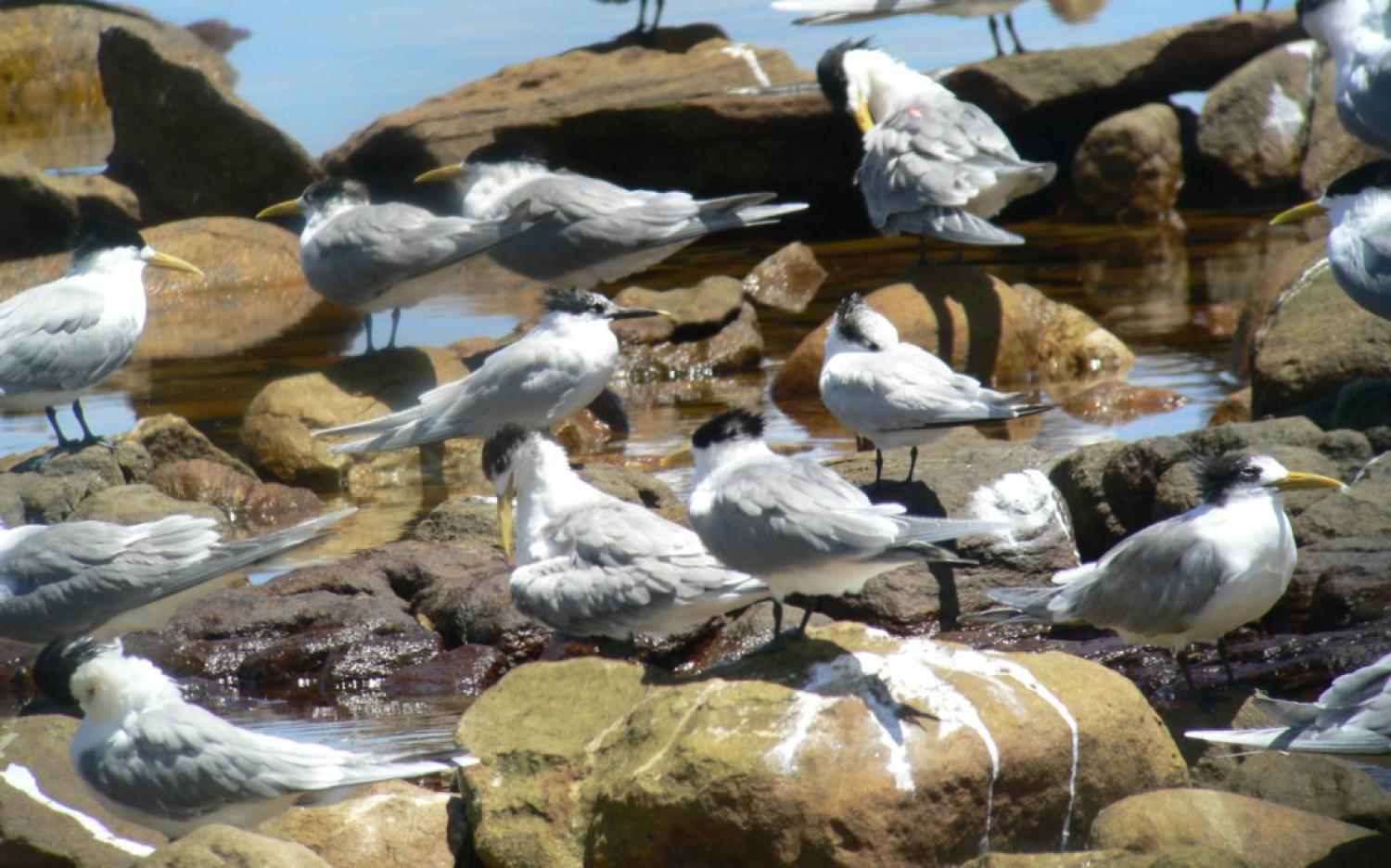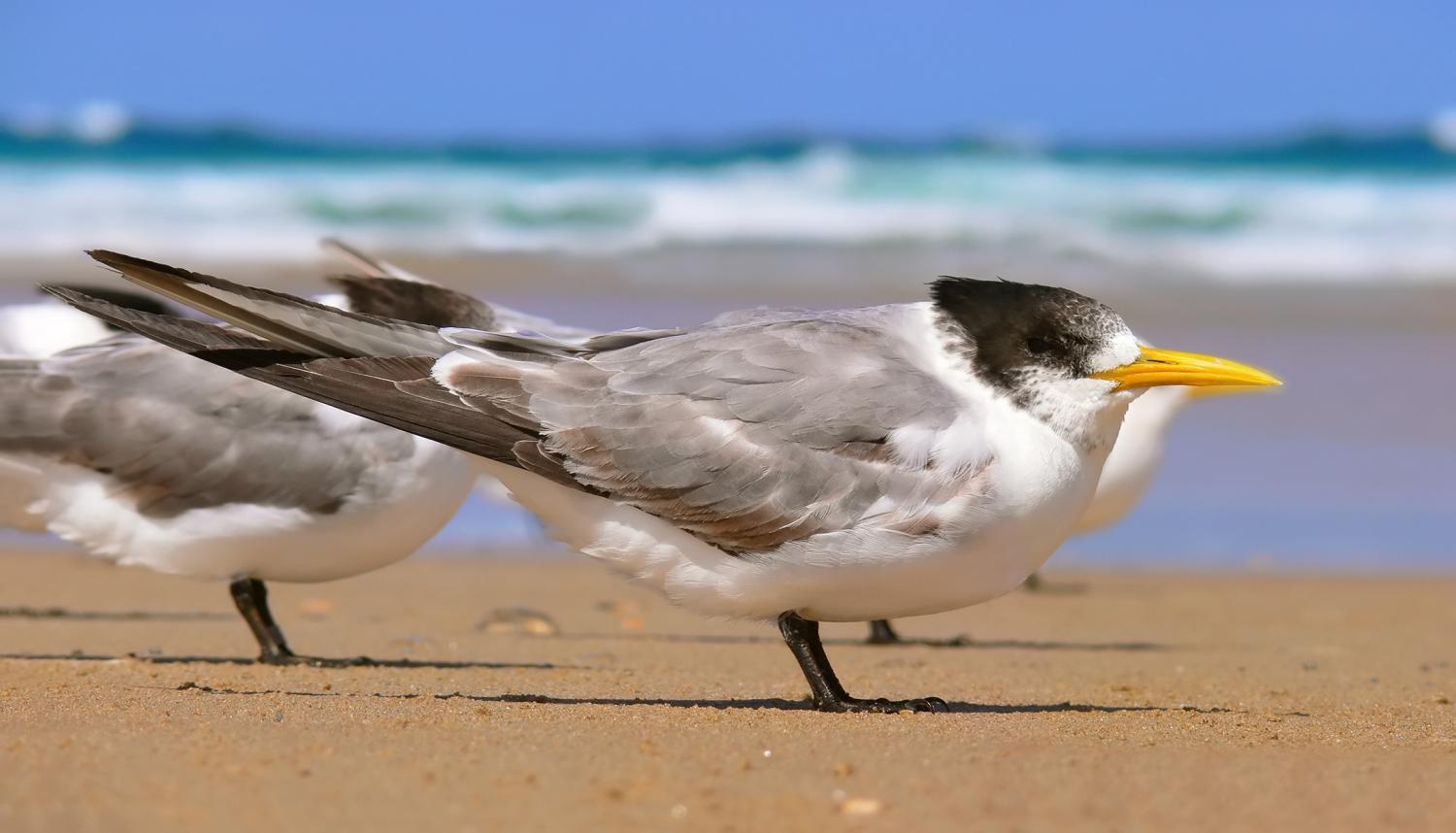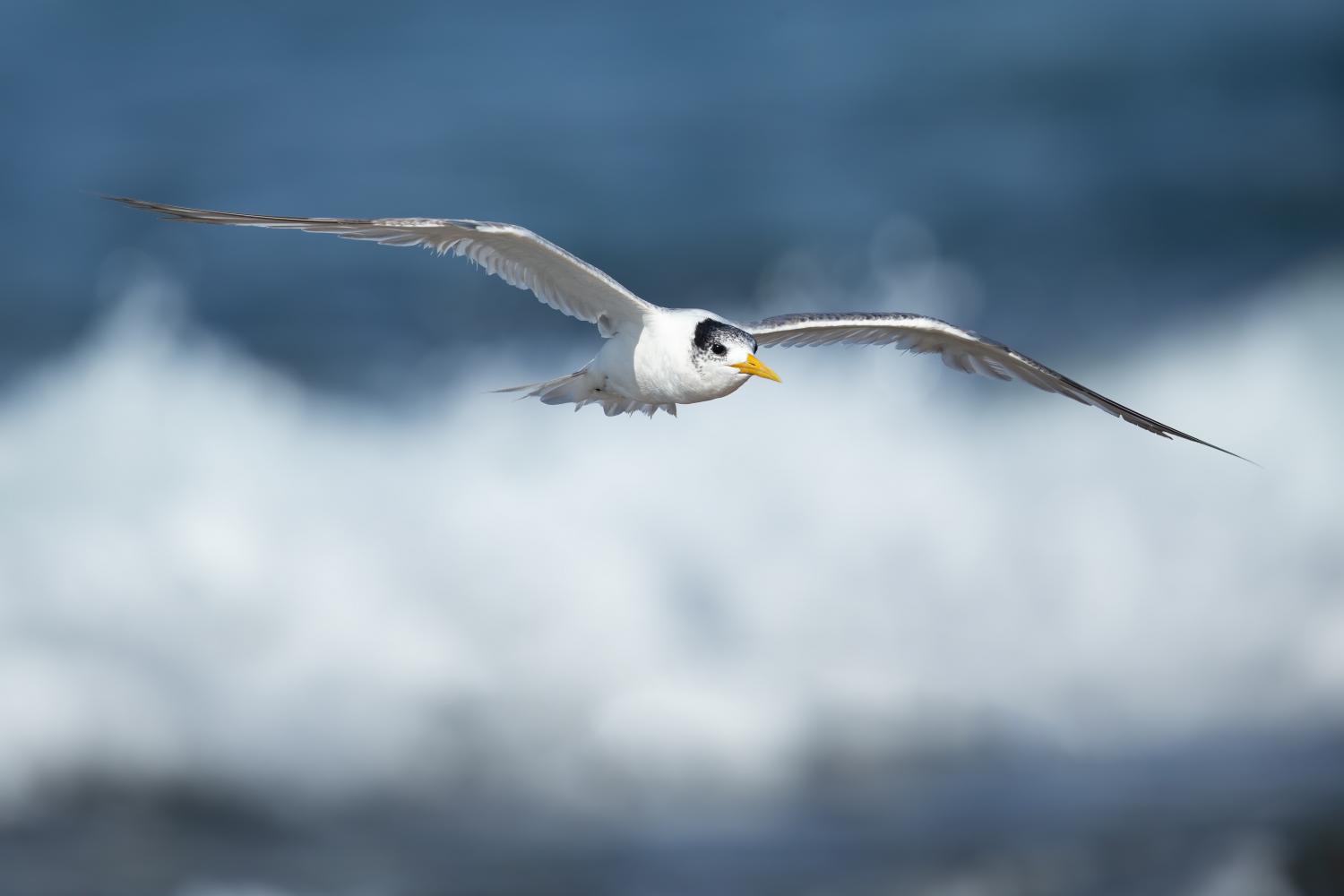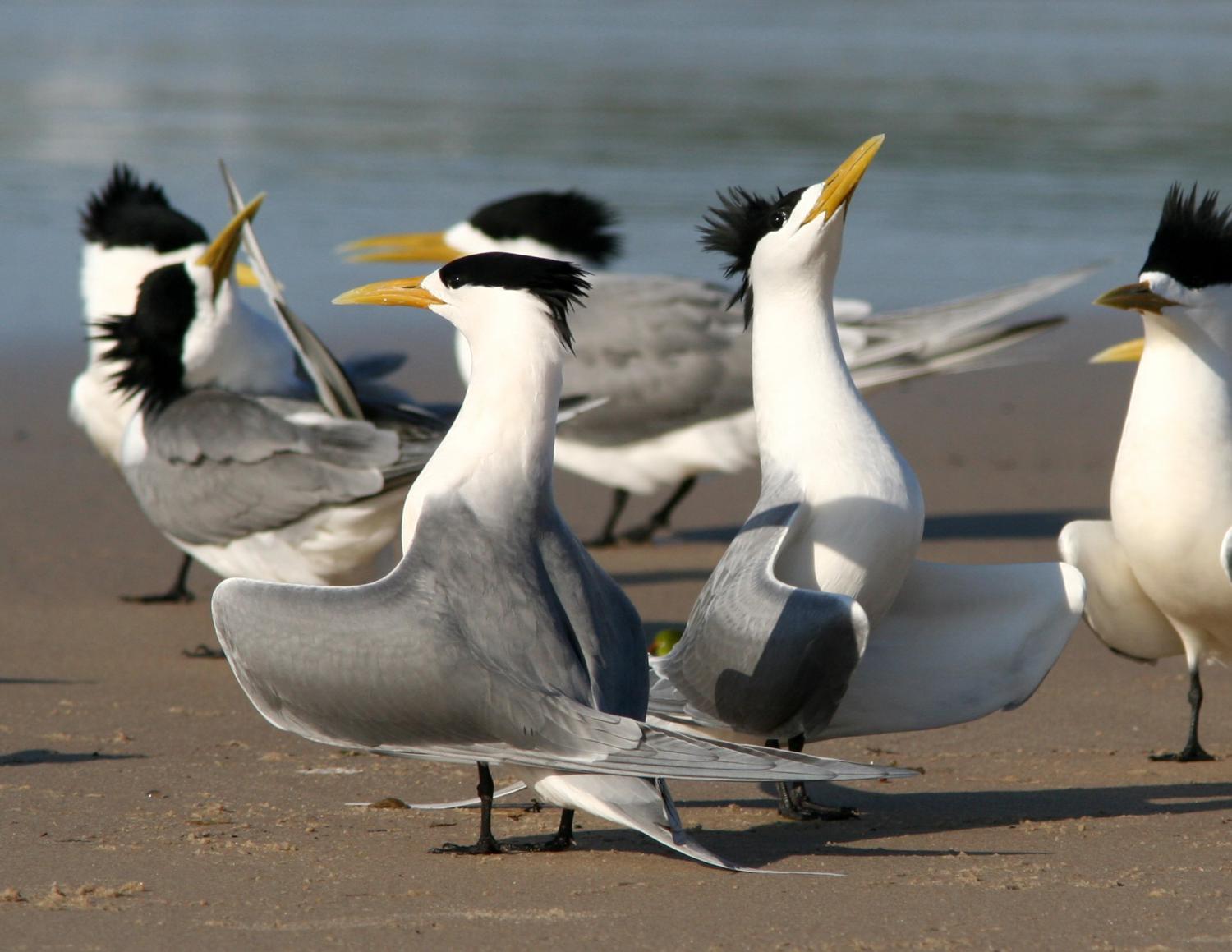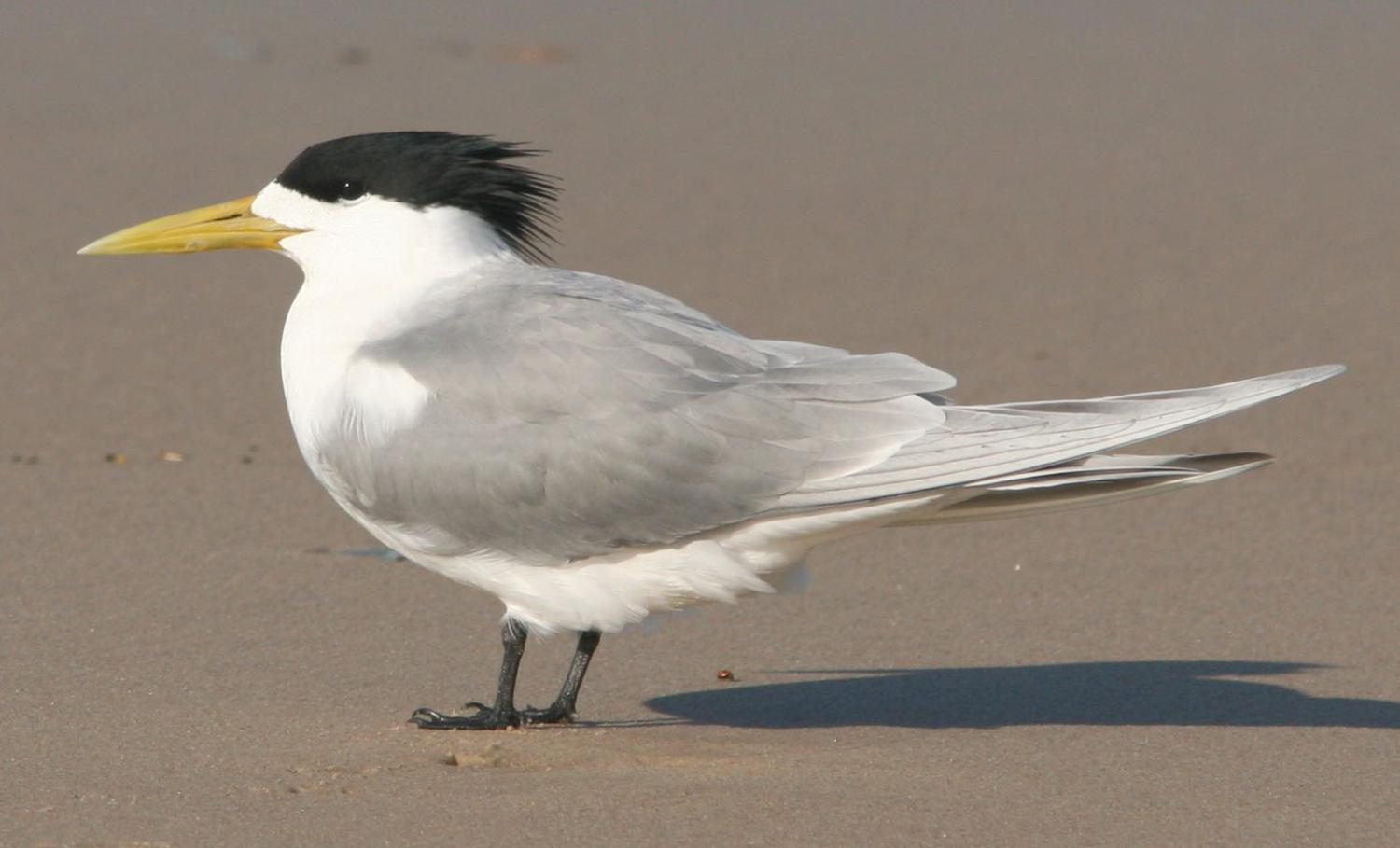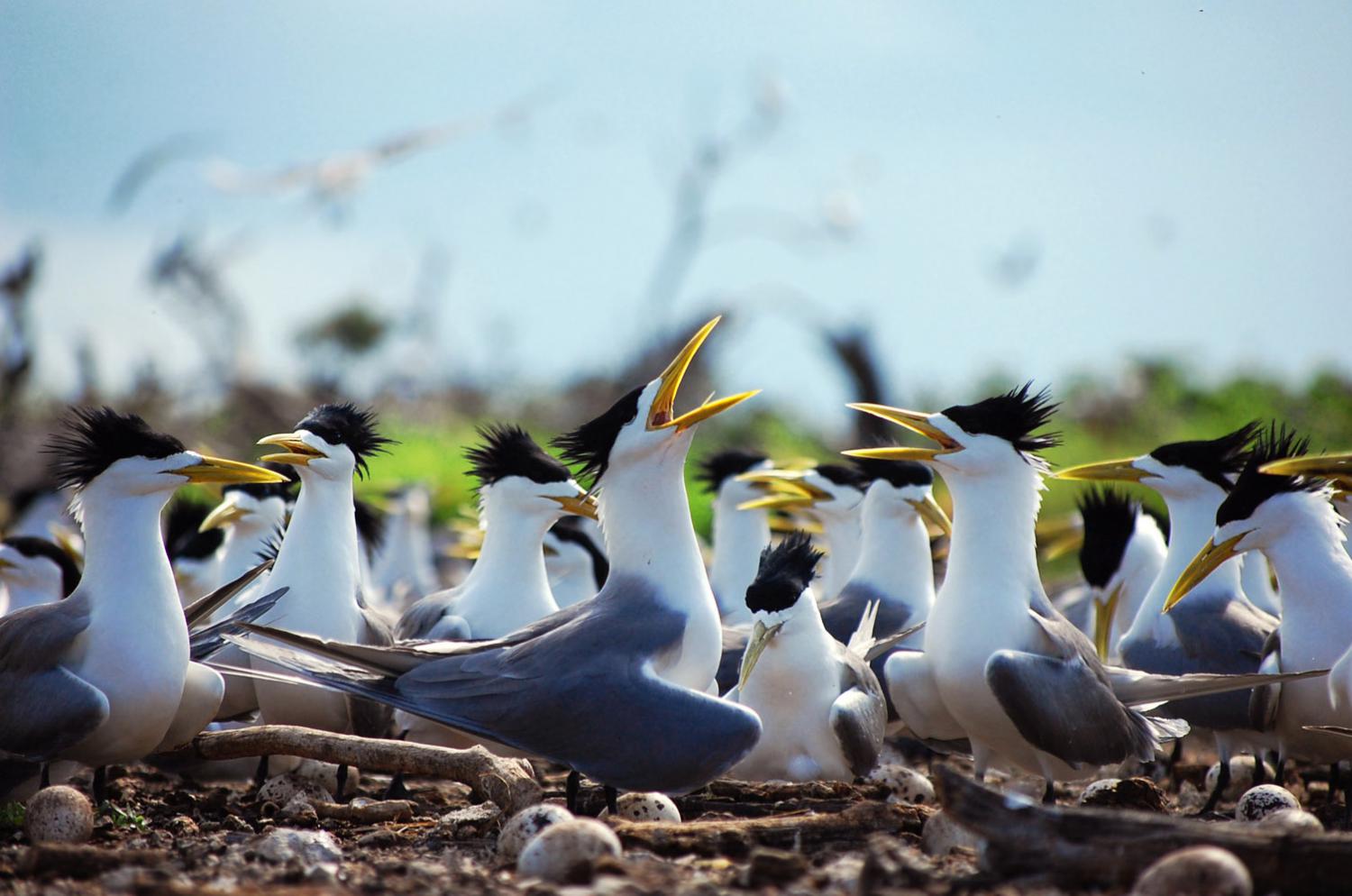Species of Thailand
Great crested tern
Thalasseus bergii
Martin Lichtenstein, 1823
In Thai: นกนางนวลแกลบหงอนใหญ่
The greater crested tern (Thalasseus bergii), also called crested tern or swift tern, is a tern in the family Laridae that nests in dense colonies on coastlines and islands in the tropical and subtropical Old World. Its five subspecies breed in the area from South Africa around the Indian Ocean to the central Pacific and Australia, all populations dispersing widely from the breeding range after nesting. This large tern is closely related to the royal and lesser crested terns, but can be distinguished by its size and bill colour.
The greater crested tern has grey upperparts, white underparts, a yellow bill, and a shaggy black crest that recedes in winter. Its young have a distinctive appearance, with strongly patterned grey, brown and white plumage, and rely on their parents for food for several months after they have fledged. Like all members of the genus Thalasseus, the greater crested tern feeds by plunge diving for fish, usually in marine environments; the male offers fish to the female as part of the courtship ritual.
This is an adaptable species that has learned to follow fishing boats for jettisoned bycatch, and to use unusual nest sites such as the roofs of buildings and artificial islands in salt pans and sewage works. Its eggs and young are taken by gulls and ibises, and human activities such as fishing, shooting and egg harvesting have caused local population declines. There are no global conservation concerns for this bird, which has a stable total population of more than 500, 000 individuals.
Taxonomy
The terns, family Sternidae, are small to medium-sized seabirds closely related to the gulls, skimmers and skuas. They are gull-like in appearance, but typically have a lighter build, long pointed wings (which give them a fast, buoyant flight), a deeply forked tail and short legs. Most species are grey above and white below, and have a black cap that is reduced or flecked with white in the winter.
The greater crested tern was originally described as Sterna bergii by German naturalist Martin Lichtenstein in 1823, but was moved to its current genus, Thalasseus, after mitochondrial DNA studies confirmed that the three main head patterns shown by terns (no black cap, black cap, black cap with a white forehead) corresponded to distinct clades.
The greater crested tern's closest relatives within its genus appear to be the lesser crested tern (T. bengalensis), and the royal tern (T. maximus). The DNA study did not include the critically endangered Chinese crested tern (T. bernsteini) but, as that bird was formerly considered to be conspecific with the greater crested tern as a synonym of the subspecies T. b. cristatus, it is presumably also very closely related.
The generic name of the greater crested tern is derived from Greek Thalassa, "sea", and the species epithet bergii commemorates Carl Heinrich Bergius, a Prussian pharmacist and botanist who collected the first specimens of this tern near Cape Town.
The greater crested tern has about five geographical races, differing mainly in the colour of the upperparts and bill. These are listed below in taxonomic sequence. A similar number of other potential subspecies have been proposed, but are not considered valid.
| Subspecies | Breeding range | Distinctive features | Population estimates |
|---|---|---|---|
| T. b. bergii, (Lichtenstein, 1823) | Coasts of South Africa and Namibia | Dark grey above, slightly larger than thalassina, least white on head | 20, 000 individuals (inc 6, 336 breeding pairs in South Africa and up to 1, 682 pairs in Namibia) |
| T. b. enigma, (Clancey, 1979) | Zambezi delta, Mozambique, south to Durban, South Africa | Palest subspecies | 8, 000–10, 000 individuals in Madagascar and Mozambique |
| T. b. cristata, (Stephens, 1826) | Eastern Indian Ocean, Australia and western Pacific Ocean | Like bergii, with tail, rump and back concolorous. paler in Australia | 500, 000+ individuals in Australia |
| T. b. thalassina, (Stresemann, 1914) | Western Indian Ocean | Small and pale, larger and less pale in south of range | 2, 550–4, 500 individuals in Eastern Africa and Seychelles |
| T. b. velox, (Cretzschmar, 1827) | Red Sea, Persian Gulf, northern Indian Ocean | Largest, heaviest, darkest and longest-billed subspecies | 33, 000 in Middle East (inc 4, 000 pairs Oman and 3, 500 pairs on islands off Saudi Arabia) |
Description
The greater crested tern is a large tern with a long (5.4 – 6.5 cm disp=or) yellow bill, black legs, and a glossy black crest that is noticeably shaggy at its rear. The breeding adult of the nominate subspecies T. b. bergii is 46 – 49 cm round=0.5 long, with a 125 – 130 cm round=0.5 wing-span; this subspecies weighs 325–397 g (11.4–14.0 oz). The forehead and the underparts are white, the back and inner wings are dusky-grey. In winter, the upperparts plumage wears to a paler grey, and the crown of the head becomes white, merging at the rear into a peppered black crest and mask.
The adults of both sexes are identical in appearance, but juvenile birds are distinctive, with a head pattern like the winter adult, and upperparts strongly patterned in grey, brown, and white; the closed wings appear to have dark bars. After moulting, the young terns resemble the adult, but still have a variegated wing pattern with a dark bar on the inner flight feathers.
The northern subspecies T. b. velox and T. b. thalassina are in breeding plumage from May to September or October, whereas the relevant period for the two southern African races is from December to April. For T. b. cristata, the moult timing depends on location; birds from Australia and Oceania are in breeding plumage from September to about April, but those in Thailand, China and Sulawesi have this appearance from February to June or July.
The royal tern is similar in size to this species, but has a heavier build, broader wings, a paler back and a blunter, more orange bill. The greater crested often associates with the lesser crested tern, but is 25% larger than the latter, with a proportionately longer bill, longer and heavier head, and bulkier body. Lesser crested tern has an orange-tinted bill, and in immature plumage it is much less variegated than greater crested.
The greater crested tern is highly vocal, especially at its breeding grounds. The territorial advertising call is a loud, raucous, crow-like . Other calls include a given at the nest by anxious or excited birds, and a hard in flight.
Distribution and habitat
The greater crested tern occurs in tropical and warm temperate coastal parts of the Old World from South Africa around the Indian Ocean to the Pacific and Australia. The subspecies T. b. bergii and T. b. enigma breed in Southern Africa from Namibia to Tanzania, and possibly on islands around Madagascar. There is then a break in the breeding distribution of this species until Somalia and the Red Sea, and another discontinuity further east in southern India.
The greater crested tern breeds on many islands in the Indian Ocean including Aldabra and Etoile in the Seychelles, the Chagos Archipelago, and Rodrigues. There are colonies on numerous Pacific islands, including Kiribati, Fiji, Tonga, the Society Islands and the Tuamotus.
The nests are located on low‑lying sandy, rocky, or coral islands, sometimes amongst stunted shrubs, often without any shelter at all. When not breeding, the greater crested tern will roost or rest on open shores, less often on boats, pilings, harbour buildings and raised salt mounds in lagoons. It is rarely seen on tidal creeks or inland waters.
All populations of greater crested tern disperse after breeding. When Southern African birds leave colonies in Namibia and Western Cape Province, most adults move east to the Indian Ocean coastline of South Africa. Many young birds also travel east, sometimes more than 2, 000 km, but others move northwards along the western coast. T. b. thalassina winters on the east African coast north to Kenya and Somalia and may move as far south as Durban. Populations of T. b. velox breeding from the Persian Gulf eastwards appear to be sedentary or dispersive rather than truly migratory, but those breeding in the Red Sea winter south along the east African coast to Kenya. T. b. cristata mostly stays within 400 km of its colonies, but some birds wander up to around 1, 000 km. This species has occurred as a vagrant to Hawaii, New Zealand, North Korea, Jordan, and Israel.
In India, the Greater crested tern is protected in the PM Sayeed Marine Birds Conservation Reserve.
Breeding
The greater crested tern breeds in colonies, often in association with other seabirds. It is monogamous and the pair bond is maintained through the year and sometimes in consecutive breeding seasons. The colony size is related to the abundance of pelagic fish prey, and the largest documented colony, with 13, 000 to 15, 000 pairs, is in the Gulf of Carpentaria in northern Australia, a region which also supports major colonies of other seabirds. Since nesting in this area follows the summer monsoonal flooding, it is presumably a response to fish stocks rising, probably due to river run-off providing extra nutrient to the Gulf. This tern does not show site fidelity, frequently changing its nest site from year to year, sometimes by more than 200 km.
A male greater crested tern establishes a small area of the colony in preparation for nesting, and initially pecks at any other tern entering his territory. If the intruder is another male, it retaliates in kind, and is normally vigorously repelled by the incumbent. A female entering the nest area reacts passively to the male's aggression, enabling him to recognise her sex and initiate pair formation by display, including head raising and bowing; this behaviour is frequently repeated during nesting to reinforce the bond between the pair. Terns also use fish as part of the courtship ritual. One bird flies around the colony with a fish in its beak, calling loudly; its partner may also fly, but the pair eventually settle and the gift is exchanged.
The nest is a shallow scrape in the sand on open, flat or occasionally sloping ground. It is often unlined, but sometimes includes stones or cuttlefish bones. One, sometimes two, eggs are laid and incubated by both parents for 25 to 30 days prior to hatching. The eggs are cream with blackish streaks. Egg laying is synchronised within a breeding colony and more tightly so within sub-colonies. Parents do not recognize their own eggs or newly hatched chicks, but are able to distinguish their chicks by the time they are two days-old, shortly before they begin to wander from the nest. The precocial chicks, which are very pale with black speckling, are brooded and fed by both parents, but may gather in crèches when older. The young terns fledge after 38 to 40 days, but remain dependent on the parents after leaving the colony until they are about four months old.
In South Africa, this species has adapted to breeding on the roofs of building, sometimes with Hartlaub's gull, which also shares the more typical nesting sites of the nominate race. In 2000, 7.5% of the population of this subspecies bred on roofs. Artificial islands in salt pans and sewage works have also recently been colonised by this adaptable seabird.
Adult terns have few predators, but in Namibia immature birds are often robbed of their food by kelp gulls, and that species, along with Hartlaub's gull, silver gull and sacred ibis, has been observed feeding on eggs or nestlings, especially when colonies are disturbed. Smaller subcolonies with a relatively larger numbers of nests located on the perimeter are subject to more predation. In Australia, predation by cats and dogs, and occasional deaths by shooting or collisions with cars, wires or light-towers have been documented.
Commercial fisheries can have both positive and negative effects on the greater crested tern. Juvenile survival rates are improved where trawler discards provide extra food, and huge population increases in the southeastern Gulf of Carpentaria are thought to have been due to the development of a large prawn trawl fishery. Conversely, purse-seine fishing reduces the available food supply, and sizeable fluctuations in the numbers of great crested terns breeding in the Western Cape of South Africa are significantly related to changes in the abundance of pelagic fish, which are intensively exploited by purse-seine fishing. Terns may be killed or injured by collisions with trawl warps, trapped in trawls or discarded gear, or hooked by longline fishing, but, unlike albatrosses and petrels, there is little evidence that overall numbers are significantly affected.
An unusual incident was the incapacitation of 103 terns off Robben Island, South Africa by marine foam, generated by a combination of wave action, kelp mucilage and phytoplankton. After treatment, 90% of the birds were fit to be released.
Feeding
Fish are the main food of the greater crested tern, found to make up nearly 90% of all prey items with the remainder including cephalopods, crustaceans and insects. Unusual vertebrate prey included agamid lizards and green turtle hatchlings.
The great crested tern feeds mostly at sea by plunge diving to a depth of up to 1 m, or by dipping from the surface, and food is usually swallowed in mid-air. Birds may forage up to 10 km from land in the breeding season. Prey size ranges from 7 – 138 mm in length and up to 30 g in weight. Shoaling pelagic fish such as anchovy and sardine are typical prey, but bottom-living species are taken as discards from commercial fishing. This tern actively follows trawlers, including at night, and during the fishing season trawl discards can constitute 70% of its diet. Prawn fishing is particularly productive in providing extra food, since prawns usually represent only 10–20% of the catch, the remaining being bycatch, mainly fish such as cardinalfish and gobies.
A study of an area of the Great Barrier Reef where the number of breeding great crested terns has grown ten-fold, probably due to extra food from trawl by-catch, suggested that lesser crested and sooty terns have moved away and now breed on a part of the reef where fishing is banned. It is possible that the large increase in the number of greater crested terns may have affected other species through competition for food and nesting sites.
Terns have red oil droplets in the cone cells of the retinas of their eyes. This improves contrast and sharpens distance vision, especially in hazy conditions. Birds that have to see through an air/water interface, such as terns and gulls, have more strongly coloured carotenoid pigments in the cone oil drops than other avian species. The improved eyesight helps terns to locate shoals of fish, although it is uncertain whether they are sighting the phytoplankton on which the fish feed, or observing other terns diving for food. Tern's eyes are not particularly ultraviolet sensitive, an adaptation more suited to terrestrial feeders like the gulls.
Status
The greater crested tern has a widespread distribution range, estimated at 1–10 million square kilometres (0.4–3.8 million square miles). The population has not been quantified, but it is not believed to approach the thresholds for either the size criterion (fewer than 10, 000 mature individuals) or the population decline criterion (declining more than 30% in ten years or three generations) of the IUCN Red List. For these reasons, the species is evaluated as being of Least Concern at the global level. However, there are concerns for populations in some areas such as the Gulf of Thailand where the species no longer breeds, and in Indonesia where egg harvesting has caused declines.
All subspecies except T. b. cristata are covered under the Agreement on the Conservation of African-Eurasian Migratory Waterbirds (AEWA). Parties to the Agreement are required to engage in a wide range of conservation strategies described in a detailed action plan. The plan is intended to address key issues such as species and habitat conservation, management of human activities, research, education, and implementation.
This article uses material from Wikipedia released under the Creative Commons Attribution-Share-Alike Licence 3.0. Eventual photos shown in this page may or may not be from Wikipedia, please see the license details for photos in photo by-lines.
Category / Seasonal Status
BCST Category: Recorded in an apparently wild state within the last 50 years
BCST Seasonal statuses:
- Resident or presumed resident
- Non-breeding visitor
Scientific classification
- Kingdom
- Animalia
- Phylum
- Chordata
- Class
- Aves
- Order
- Charadriiformes
- Family
- Laridae
- Genus
- Thalasseus
- Species
- Thalasseus bergii
Common names
- English:
- Crested tern
- Great crested tern
- Swift tern
- French: Sterne huppée
- Thai: นกนางนวลแกลบหงอนใหญ่
Subspecies
Thalasseus bergii bergii, Martin Hinrich Carl Lichtenstein, 1823
Range: Coasts of South Africa and Namibia. Dark grey above, slightly larger than thalassina, least white on head. 20, 000 individuals (inc 6, 336 breeding pairs in South Africa and up to 1, 682 pairs in Namibia)
Thalasseus bergii cristata, James Francis Stephens, 1826
Range: Eastern Indian Ocean, Australia and western Pacific Ocean. Like bergii, with tail, rump and back concolorous. paler in Australia. 500, 000+ individuals in Australia
Thalasseus bergii enigma, Phillip Alexander Clancey, 1979
Range: Zambezi delta, Mozambique, south to Durban, South Africa. Palest subspecies. 8, 000–10, 000 individuals in Madagascar and Mozambique
Thalasseus bergii thalassina, Erwin Stresemann, 1914
Range: Western Indian Ocean. Small and pale, larger and less pale in south of range. 2, 550–4, 500 individuals in Eastern Africa and Seychelles
Thalasseus bergii velox, Philipp Jakob Cretzschmar, 1827
Range: Red Sea, Persian Gulf, northern Indian Ocean. Largest, heaviest, darkest and longest-billed subspecies. 33, 000 in Middle East (inc 4, 000 pairs Oman and 3, 500 pairs on islands off Saudi Arabia)
Synonyms
- Thalasseus bergii, Les Christidis & Walter E. Boles (2008)
- Thalasseus bergii, AOU Checklist (1998)
- Sterna bergii, Martin Hinrich Carl Lichtenstein (1823)
Conservation status

Least Concern (IUCN3.1)

Extinct (ONEP)
- EX (resident)/LC (migratory) -
Photos
Please help us review the bird photos if wrong ones are used. We can be reached via our contact us page.
Range Map

- Ao Phang-Nga National Park
- Bang Pu Recreation Centre
- Chaiya District, Surat Thani
- Chumphon Coast
- Hat Chao Mai National Park
- Khao Laem Ya - Mu Ko Samet National Park
- Khao Lak - Lam Ru National Park
- Khao Sam Roi Yot National Park
- Khura Buri District, Phang Nga
- Klaeng District, Rayong
- Ko Lanta National Park
- Ko Libong
- Ko Phayam
- Ko Samui District, Surat Thani
- Ko Tao
- Laem Pak Bia
- Mueang Krabi District, Krabi
- Mueang Pattani District, Pattani
- Mueang Phang Nga District, Phang Nga
- Mueang Phuket District, Phuket
- Mueang Samut Sakhon District, Samut Sakhon
- Mueang Samut Songkhram District, Samut Songkhram
- Nakhon Si Thammarat Coast
- Pak Thale
- Pattani Coast
- Phi Phi Islands
- Samut Prakan Province
- Sattahip District, Chonburi
- Satun Coast
- Similan Islands
- Songkhla Coast
- Surat Thani Coast
- Surin Islands
- Takua Pa District, Phang Nga
- Tarutao National Marine Park

